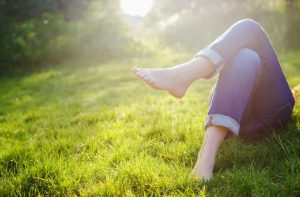How a grounding meditation can teach you how to live in the moment and stop worrying
So you’re wondering how to stop worrying and live in the moment.
Mindfulness is everywhere. In the magazines you read, the inspirational posts on social media. Even your kids are coming from school and telling you about mindfulness.
So how come you can’t put it into practice? You are still overthinking everything, getting sucked into ruminating over regrets from the past or anticipating events that might happen in the future?
Perhaps the answer lies in just one element of mindfulness. Grounding.
Rooted in reality
My husband and I met on the other side of the world and it’s a wonderful story, but what we generally miss out is this …
Within a couple of weeks of meeting my husband, he got very sick with food poisoning, but the symptoms didn’t show themselves until we were on an overnight train from Bangkok to Laos. He spent most of the night trapped in a cramped, metal tiny toilet at the opposite end of the carriage.
But what stands out most to me from that train trip was in the morning. We were still rocking and rolling down the tracks, which must have been tortuous to his dodgy tummy.
 But he told me it felt so good for me to hold him. Not tightly, but to have my hands on him in some way. He said later ‘it kept me grounded’.
But he told me it felt so good for me to hold him. Not tightly, but to have my hands on him in some way. He said later ‘it kept me grounded’.
What I imagine, is that in his dizzy, delirious state, having two solid hands on him were keeping him steady and rooted in reality.
This is what grounding techniques are. In the psychological sense, grounding means to bring you back to the present moment. Often grounding techniques use the five senses to keep you aware of what is going on around you. Such as naming five pieces of furniture in a room.
Or noticing the sounds around you.
You may recognize these as typical mindfulness activities. And you’d be right.
An explanation of psychological grounding techniques
In psychology, grounding techniques are a tool to keep people with PTSD or dissociative disorders rooted to the here and now when they are having flashbacks or spells of dissociation.
It does not prevent the flashbacks or dissociative experiences but it can help keep the person rooted to reality and make it easier to come back or help the experience pass more quickly.
Grounding will help you if your mind often drifts into the past or future.

What if I have a terrible vacation? What if my son gets ill? What if I crash the car? What if I don’t do a good job?
Often news events can trigger many unfortunate memories for you. Grounding can help you ride the waves of being wrapped up in painful memories or grief.
It’s not meant to avoid these thoughts but to help you weather the storm by being tethered to something strong. You come out of the experience less emotionally drained.
Earthing
In spirituality, grounding is often seen as being connected to Mother Nature or the Earth. Something like walking barefoot physically keeps us rooted to the earth.
Grounding or earthing is about having direct skin contact to the earth. Most of us have stopped playing barefoot outside. So now there are grounding devices which literally plug you in to the grounding elements of the earth.
Research has started to show the benefits of earthing and probably is connected to why forest bathing and being outside has benefits to your well-being.
Why use a grounding meditation?
A grounding meditation is very similar to a mindfulness meditation. But it adds an extra element. Using the feet to feel physically rooted to the ground, anchoring to your breath and I like to go a step further and use guided imagery to feel a connection to nature.
A good grounding meditation will help you to feel rooted to the stabilizing properties of the earth, and focus your mind and energy on the present moment.
How to do a grounding meditation
SIMPLE GROUNDING MEDITATION
- Find a quiet and safe time, free from distractions.
- Take time to notice your breath. Follow the breath and really listen to it. Like you’ve never noticed it before.
- You are able to this while doing an activity e.g., driving or washing up, as long as you don’t close your eyes.
- After focusing on your breath, it’s time to focus on your feet. Notice any sensations in your feet without actually touching them.
- Now try to focus on breathing all the way down into your feet. If you are a visual person, this is very easy to imagine. If you are a kinesthetic learner, breathe in until your feel no more space in your lungs and then push down on your toes to trigger your out breath.
FULL GROUNDING MEDITATION WITH GUIDED IMAGERY
- Find a quiet time, free from distractions
- Start by focusing on your breath. Follow the journey of your breath, in and out.
- Take the time to really listen to your breath.
- Now, focus on your feet. Sit or stand so your feet touch the ground and breathe down all the way into your feet.
- Imagine a long cord coming out of the base of your spine and being rooted down to the core of the earth, like the root of a tree.
- Feel the nutrients and energy of the earth coming up through that root and moving through your body. Filling you with earthy energy.
- Now, move on to the guided imagery. Imagine a beautiful small home in the country. It’s an early morning. You rise early and leave the house.
- You are greeted by a beautiful country scene. The birds are chirping and there is a small brook with running water. You wash your face in the stream.
- Then you take off your shoes and walk barefoot in the grass, with the dewdrops sparkling in the sun. Feel yourself sinking, step by step into the soft, mossy grass. Feeling rooted with stillness.
- You return to your home feeling refreshed.
- Come back to your breath. Listening to the sounds in the here and now. Notice the sensations in your body.
- Bat open your eyes and feel the stillness in your mind. With new focus to carry on with your day.
If you haven’t got time for a grounding meditation
You can anchor yourself to the present moment by using your senses, one by one. So, using sight, touch, taste, smell, and sound to notice actual objects around you. This can shift your focus to the present moment. An example is the 5, 4, 3, 2, 1 technique described here .
With a little focus you will find you can use a grounding meditation (or elements of it) to help you cope with anxiety while driving, while traveling, or in social situations. Any place where you feel panicky or when you are worrying more than usual, it will help keep your feet firmly on the ground.
Conclusion
Grounding meditation is a technique to use when you find yourself getting into a pattern of overthinking. Using the helium balloon analogy it helps keep your mind tied to the here and now rather than flying off into another unhelpful realm.
It is not about avoidance of these panicky ‘what if’ thoughts, but to help you become more relaxed and safe.
If you are ready to listen to a guided grounding mediation, I have created a free meditation on YouTube for you to try. I did not include music in this one because I find when you want to be grounded, music is a distraction.
Using a guided meditation is often easier to follow than an unstructured meditation. Helping you to focus your mind and use guidance to focus on the breath and bodily sensations.
Looking for more ways to overcome anxiety and stress? Check out my post on yoga and stress. Yoga is a particularly good way to keep grounded and tune into your body.

